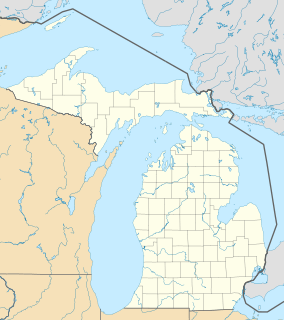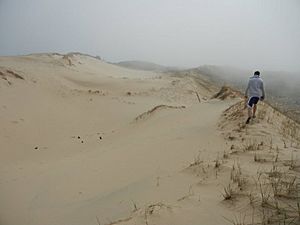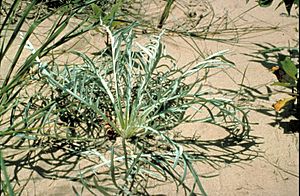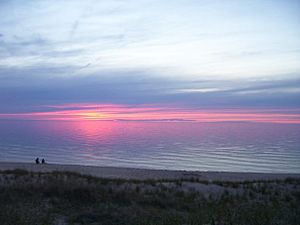Nordhouse Dunes Wilderness facts for kids
Quick facts for kids Nordhouse Dunes Wilderness |
|
|---|---|
|
IUCN Category Ib (Wilderness Area)
|
|
| Location | Manistee County, Michigan, United States |
| Nearest city | Ludington, Michigan |
| Area | 3,450 acres (14 km2) |
| Established | 1987 |
| Governing body | U.S. Forest Service |
The Nordhouse Dunes Wilderness is a special natural area in Michigan, United States. It covers about 3,450 acres (14 square kilometers). This beautiful wilderness is part of the Manistee National Forest. It's famous for its 4 miles (6.4 km) of untouched shoreline along Lake Michigan. It's a great place to explore nature!
Contents
How the Dunes Were Formed
Ancient Lakes and Sand
Long, long ago, about 3,500 years ago, the water levels in the Great Lakes were much higher. This time was called the Nipissing stage. During this stage, Lake Huron and Lake Michigan were connected. They were also much deeper, about 605 feet (184 meters) above sea level.
As the lake levels slowly dropped, huge amounts of sand were left behind. Strong winds blowing off Lake Michigan then shaped this sand. These winds created the amazing sand dunes we see today.
The Big Sable Dunes Complex
The shoreline around Big Sable Point was shaped into a large area called the Big Sable Dunes complex. This area is about 6,270 acres (25.4 square kilometers). It has sandy hills, small lakes, and many different plants and animals. Some of these dunes can reach heights of 140 feet (42 meters) above the lake.
The Nordhouse Dunes make up the northern part of this special dune area. The southern part, about 2,820 acres (11.4 square kilometers), is found within Michigan's Ludington State Park.
Plants and Animals of Nordhouse Dunes
Forest Life and Plant Succession
The older dunes, which are farther from Lake Michigan, have had a long time to grow. Here, a process called plant succession has created a thick forest. This means different types of plants have grown over time, changing the land.
You can find many types of trees in this forest. These include beech trees, sugar maples, red oaks, and white oak trees. There are also some evergreen trees like the red pine and Michigan's state tree, the white pine.
Special Dune Plants
Closer to the lake, where the dunes are still moving, you'll find different plants. These are early-succession plants, meaning they are the first to grow in new areas. Examples include the juniper bush and the jack pine.
One very special plant here is the Pitcher's thistle. This plant is a threatened species, which means it's rare and needs protection. The Nordhouse Dunes are home to one of the largest groups of these thistles. In 1991, about 3,100 Pitcher's thistle plants were counted here.
Wildlife in the Dunes
The most common large animal you might see is the whitetail deer. You might also spot smaller animals like coyotes, foxes, porcupines, and raccoons.
Other animals live here too, but they are harder to see. These include the black bear and the bobcat. They usually stay hidden from visitors.
Nordhouse Dunes Today
History of the Wilderness Area
In the past, during the 1800s and early 1900s, much of northwestern Michigan was heavily logged. This means many trees were cut down. Later, in 1938, the U.S. Congress decided to protect some of this land. They made it part of the Manistee National Forest.
Then, in 1987, Congress officially named the Nordhouse Dunes a wilderness area. This means it is a special place where nature is protected and kept wild.
Visiting the Dunes
There are two main parking areas if you want to visit the Nordhouse Dunes. One is at the Lake Michigan Recreation Area, on the northern side. The other is at Nurnberg Road, on the southeastern side.
While there is no entry fee for the wilderness itself, you need a special pass for your car to use the parking lots. These parking areas are easy to reach from U.S. Highway 31. This is the main road along the Lake Michigan shoreline north of Ludington.





